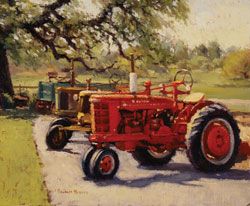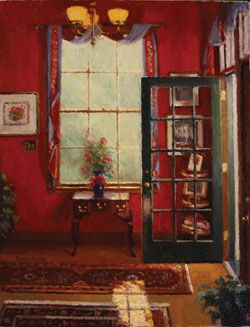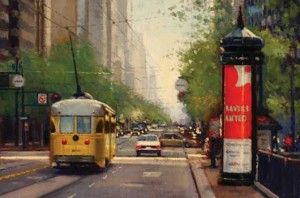Award-winning oil painter Douglas Morgan took 40 years to discover his calling as an artist
By Norman Kolpas
Listen to Douglas Morgan as he enthusiastically surveys the first four decades of his life, and you might well think that absolutely nothing foreshadowed the highly successful artist he is today. He’ll tell you about his childhood in Cleveland back in the 1950s and how he had “very little interest in art” as it was taught by the nuns at the Catholic schools he attended. He’ll explain how his mechanical engineering major at the University of Dayton helped him develop the determination and attention to detail that led him to become a successful salesman, first representing midwestern industrial manufacturers and eventually, after moving to San Francisco in the late ’70s, as a commercial real estate agent, a career he pursued for more than 20 years.
“If someone had told me back in the ’80s that I would become a fine artist in the ’90s, I would have told them they were dreaming,” Morgan laughs. “That was a career change I would never have imagined.”
But you begin to believe the inevitability of that career change once you start digging beneath the surface of Morgan’s early years. Take that professed lack of interest in art, for example. After a bit of prodding, he’ll admit, “In my teens, I would pick up a magazine every once in a while, take a piece of paper, and see how closely I could come to drawing a picture of a photo.” And how close did he come? “I was halfway decent,” he confesses. Then there’s the engineer’s attention to detail that made him a good salesman. Look at his award-winning canvases today, and that same devotion to detail is evident in every brush stroke.
Finally, another revealing fact emerges from Morgan’s account of an 18-month trip he took around the world before settling in California. “One thing I learned during that time was that I was a good photographer. I discovered I had an eye for composition,” he says. That’s putting it mildly. On travels all over Europe, through Turkey and Egypt, then on to India and Nepal, across Southeast Asia, and during a two-month sojourn in New Guinea, Morgan recalls, “I would walk an extra mile or wait hours for just the right light to get that one photograph I thought would be a good one.”
Sounds exactly like the painstaking efforts a landscape painter might make to find the perfect scene or capture the perfect moment in oils on canvas, doesn’t it? So what may sound at first like a serendipitous lark actually takes on an air of inevitability: In late 1991 at the age of 43, Morgan took his first oil painting lesson at the Academy of Art University in San Francisco.
Though he may modestly deny it, Morgan was born to be an artist. It just took him a little while longer than others to arrive at his destiny. But his path was clear once he picked up a brush and dabbed it in oils at that evening still-life class taught by artist Craig Nelson. Part of the way through the semester, Morgan himself felt he might well have found his true calling: “So I went to Craig, and I told him, ‘I’ve got some money and can afford to be a starving artist. Should I go for it?’ Craig said yes.”
The following year, Morgan enrolled in three classes at the academy. “I was getting better,” he says, “and I started to toy with the idea of taking my work to a gallery.” While still pondering that possibility, one of his paintings, a still life of two screwdrivers, was awarded top prize at the academy’s spring show. With his confidence and skill level growing, he was accepted by his first commercial dealer, and 17 years later he is still represented by The Garden Gallery in Half Moon Bay, south of San Francisco, as well as three other galleries.
Today Morgan is quite content with his midlife career change. “In terms of competitiveness, being a painter is a much less rigorous lifestyle than being a commercial real estate agent,” he laughs, pausing to add, “Of course, painting is competitive, too. But it’s not cutthroat.” The do-or-die urgency of his previous profession has been replaced, he says, by a much more satisfying lifestyle. “When you’re a painter, you can paint for the rest of your life,” he continues. “You never stop learning, you never stop going forward.”
Forward motion has carried Morgan through a wide variety of subject matter, all painted in a realist style softened by touches of impressionistic brushwork. He first gained media attention when he moved from small-scale still-life works to interior scenes, which he characterizes as “big still-life paintings—antiques in a room with light coming in from the window or lamplight throwing a pattern on the wall.”
He also began attending plein-air shows such as the Carmel Art Festival and Telluride Plein Air, where his painting THE FOURTH, depicting a street scene crowded with people awaiting the start of the town’s Independence Day parade, was a standout amidst a body of work that last year won Morgan the event’s Southwest Art award.
Such plein-air successes have led him to focus even more on landscape paintings. But landscapes for him don’t necessarily mean idyllic scenes of nature, though he certainly paints his share of rolling hills and rugged California shorelines. If Morgan happens upon a rusted old tractor, or if he spots a vintage 1950s sedan or an old San Francisco cable car, it’s likely to become the subject of one of his outdoor scenes.
“I like drama in my paintings,” he explains, “and those old things elicit a sense of warmth and nostalgia in people. I want somebody to see my paintings and go, ‘Wow! Look at how beautiful and dramatic that scene is. It really moves me. That artist must have been moved by it just as much as I am.’”
As much as he strives to elicit an emotional response, Morgan also wants to be recognized for his technical skills as a painter. “You want people to say, ‘That person really knows how to compose a painting.’ It’s all about the basics, not about gimmicks. I remember going to a talk years ago by the great painter Wayne Thiebaud,” Morgan continues, “and he said something that still resonates for me: ‘I don’t care what the critics say. All I care about is that someone looking at my paintings will recognize that I really know how to draw, really know about color and form and drama.’”
Morgan never stops working on such fundamentals as he paints six to eight hours a day, seven days a week. His studio is just a short stroll from his home in the Sonoma County wine country town of Sebastopol. “I’m continually striving to improve,” he says. “Being a fine artist and complacency don’t mix.” He estimates that he has probably completed between 175 and 200 paintings a year over the past four or five years. “My sense of color and my ability to draw are much better today because I’m constantly working on my craft.” He also notes that he’s putting more people in his paintings these days. “I probably didn’t have the confidence to do that five or six years ago,” he says.
Prolific though he may be, Morgan nonetheless goes about carefully crafting his paintings with a methodical approach typical of his engineering background. “Once I have the colors blocked in, I always work from dark to light and from thin to thicker paint,” he explains. Occasionally, he’ll step back 10 or 15 feet from the canvas. “That’s the best distance for viewing a painting, and I want to see what’s working and what’s not.” The next morning, he’ll look again. “Maybe my darks aren’t dark enough, so I’ll go back in and darken them. It’s a constant reevaluation until the painting is done.”
In the little spare time that he has, Morgan loves to look at paintings in art books and at galleries and museums. Among artists of the past, he admires John Singer Sargent, William Merritt Chase, Anders Zorn, Joaquín Sorolla, and Edgar Payne. Living artists that inspire him include Scott Christensen, John Poon, Matt Smith, Clyde Aspevig, David Leffel, and Richard Schmid. “I gravitate to a painting because of its brushwork and values, the compositional choices, and a selective palette that isn’t overdone,” says Morgan.
Whether studying the works of others or creating his own paintings, Morgan feels he has finally reached a point of balance in his career and his life, one in which the creative and analytical aspects of his personality find equal satisfaction and expression. “Before, my right brain and my left brain had never really paid attention to each other,” he says. “Now, they’re good buddies.”
Dossier
Representation
The Garden Gallery, Half Moon Bay, CA; Carmel Fine Art, Carmel, CA; Waterhouse Gallery, Santa Barbara, CA; Fairmont Gallery, Sonoma, CA; www.douglaspmorganart.com.
Featured in May 2010








